Sometimes, people give up on cycling way too soon, and I can relate. When I first started riding my bike, I had pain in body parts I didn’t know existed! My sit bones ached, my back hurt, and my hands kept going numb. With that much pain, it just wasn’t fun to ride! Thankfully, I had advice from trusted friends who helped me sort out the issues so I could actually enjoy riding.
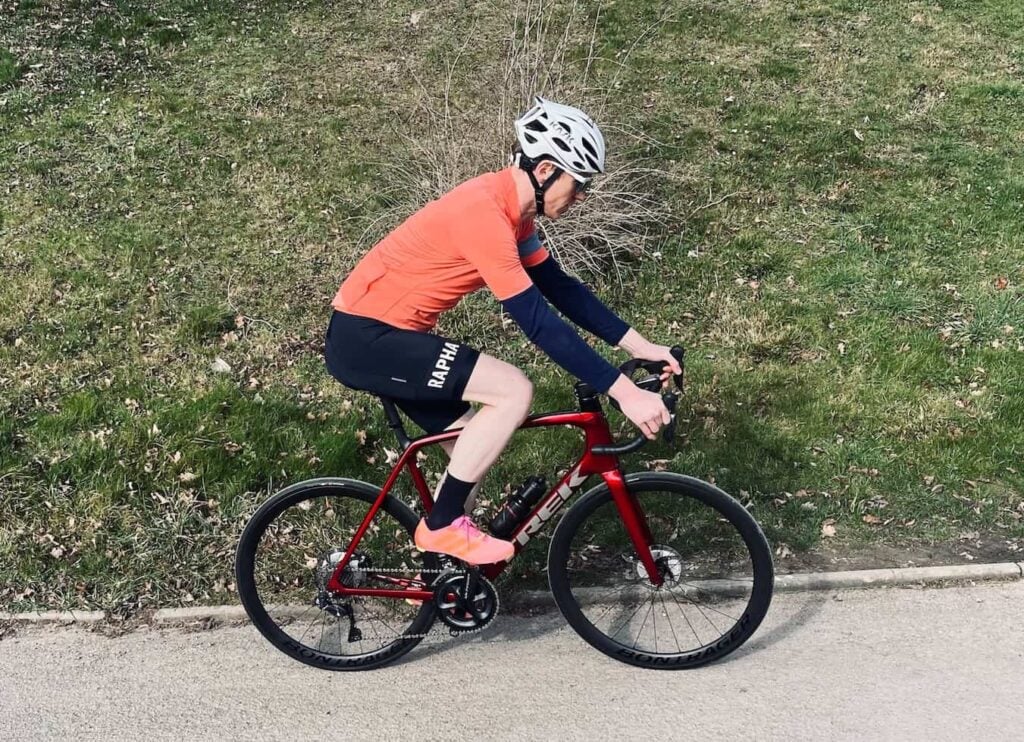
Key Takeaways
- Get the right bike, and ensure the bike fits your body and riding position
- Contact points are key, so get the right saddle for you, and check your cleat position
- Consistent riding will improve your ability to ride for longer without issues
- Combine riding with strength training to strengthen muscles and protect them from injury
- Know the common body-related cycling issues, and how to avoid them
In this article, we’re going to talk about some of the most common cycling injuries and how you can prevent them. Keep in mind that I’m not a doctor or medical professional, but I have had a few bike injuries of my own.
We’ll talk about how targeted training can also help (or hinder) you on the bike. But first, let’s talk about bike fit.
Bike Fit Is Everything
If you’ve been riding for a while, you’ve probably heard that bike fit is everything. You’ll hear it over and over again – get a professional bike fit! And there’s a good reason for that.
While bike fits can be expensive, they can also solve a lot of the pain problems you have on the bike. So getting a professional bike fit is a great place to start if you’re feeling pain while cycling.
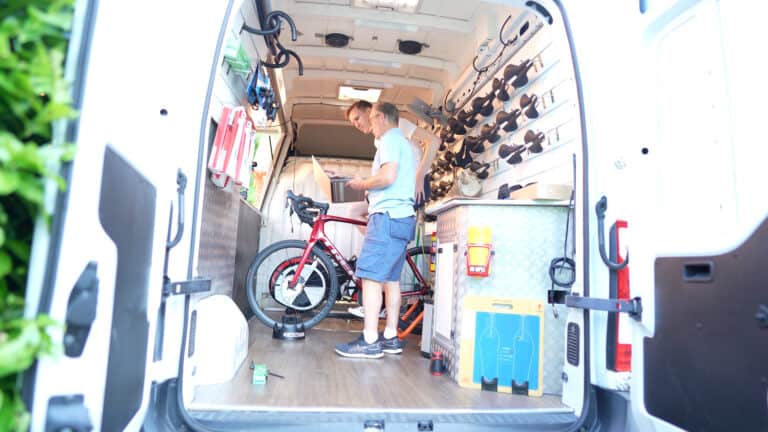
Bike Type and Bike Geometry
First of all, to prevent pain, you need to think about the type and geometry of the bike you are riding. Bike geometry is kind of a fancy way of talking about the shape of the bike, how big it is, and the angles of the different parts of the bike.
For example, a bike that is more upright – like a cruiser bike, will be much more comfortable than a race bike, which has you more bent forward towards the front of the bike. Also, if you have a lot of back pain while cycling, you might need a bike with more upright handlebars.
Race bikes generally have the most aggressive geometry, while gravel bikes and mountain bikes are a little more upright, followed by hybrids and cruisers.
What I want you to remember is that the bike type you need depends on the kind of riding you want to do and how your body feels when doing it.
Bike Fit
If you already have the right type of bike, then you need to make sure it’s the right size. A bike that is too big will make you feel stretched out and uncomfortable. This can lead to arm and neck pain as you strain to reach the handlebars.
On the other hand, a bike that is too small can cause back pain if you are too scrunched up. Also, you might have trouble getting deep breaths.
There are plenty of ways to amend bike fit issues that don’t involve getting a new bike, so don’t be afraid to get a professional bike fit on your favorite bike.
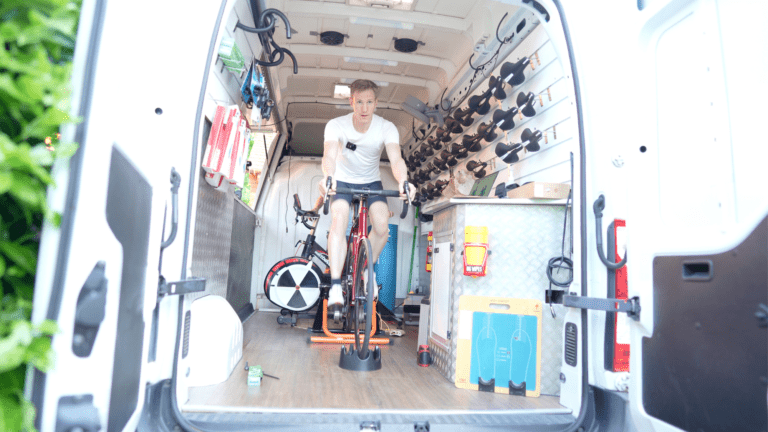
Saddle Pressure Mapping
Saddle pain can cut your ride short and send you running far, far away from your bike. Women, in particular, suffer from saddle pain, and female pro cyclists sometimes find themselves in need of surgery to repair damaged tissue.
In addition, you may discover sit bone pain, saddle sores, or just all-over painful pressure from the saddle.
But don’t let this scare you away from riding a bike! Saddle pressure pain is preventable with the right saddle and bike fit.
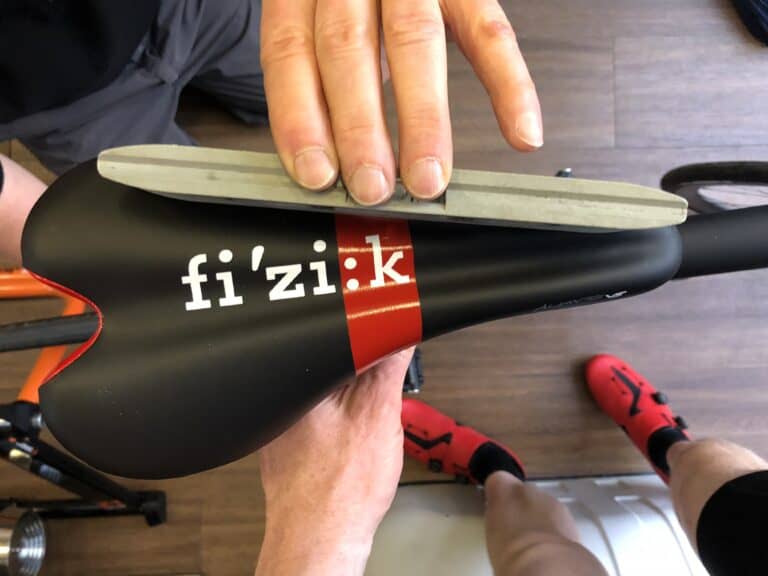
According to bikerumor.com, there are high-tech solutions to map out how you sit on your bike saddle. A special saddle cover fits over your bike seat and maps out the pressure you put on your bike saddle. You can use this information to find a saddle that suits your needs best, giving you a pain-free ride.
Of course, if you can’t find a bike fitter that uses pressure mapping, you can lay a piece of aluminum foil over your bike seat and sit on it. Then, measure the spots where your sit bones indent the foil, and that will give you a starting point for the size saddle you need.
Cleat Fits
According to cyclingmagazine.ca, “Ill-fitting shoes or misaligned cleats can result in all sorts of problems: sore feet and knees, cramp and referred pain into the back, shoulders, neck, and hands are the most common complaints and in some cases may lead to long-term damage. It’s no big surprise. Therefore, that cleat placement is significant.”
Making sure your cleats are in the right place for your body will prevent these types of injuries and increase your power availability as you pedal.
A professional bike fitter can measure your pedal stroke, the angles of your knees, and the direction your feet point, as well as address any issues such as leg length discrepancy.
Dial in Your Training
Consistent Workouts Both On and Off the Bike
If you haven’t worked out in a while, and you suddenly do a few hard workouts in a row, it’s probably going to hurt. Inconsistent training, where you work out too hard or don’t workout often enough, can cause pain and injury. You can reduce the chance of this by working out regularly.
But don’t just work out on the bike; do some off-bike workouts, such as yoga, weight training, or even walking, to strengthen weak muscles and protect yourself from injury.
TrainingPeaks offers some advice on off-the-bike workouts to help you gain strength and prevent injury.
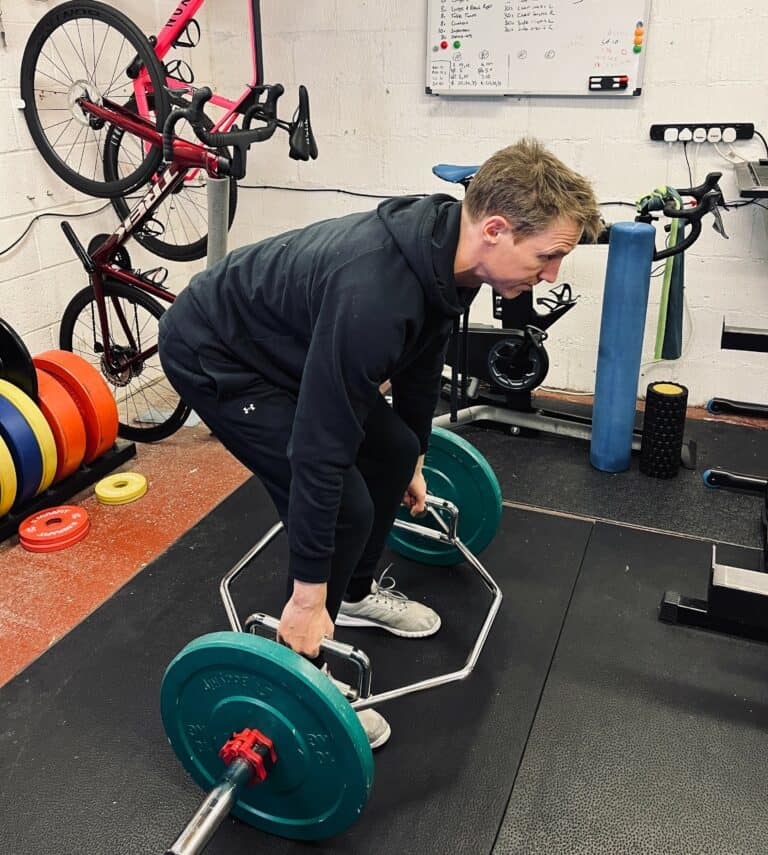
Targeted Training
Targeted training helps you dial in your cycling and training strategy to help you improve without getting fatigued or injured. You can use RPE, or rate of perceived exertion, heart rate, or FTP to target your training.
For example, training zones are targeted intensities of training that stimulate different training adaptations in the body. The easiest training zone, zone 1, helps you recover from a hard workout. Long hours spent in zone 2 help improve your fitness or endurance base. Zones 5 and 6 are challenging – you need to do some work in these zones to get faster, but if you overdo it, you can end up over-fatigued and injured.
I find that two to 3 workouts per week involving zones 5 and 6 are enough to make improvements – but more than that is not sustainable for me.
So, targeted training is about finding the right balance to get faster without getting injured. Get to know your training zones and how to use them effectively.
How Cycling Changes Your Body
Cycling improves your cardiovascular capacity and can lower your resting heart rate. In addition, it can strengthen your legs and help you build muscle. It can also help you lose weight!
Common Cycling Issues
Knee Pain From Cycling
If you have bad knees, you might have to give up running and jogging because it puts too much stress on your joints. On the other hand, cycling tends to be very easy on the joints, so you might be able to ride even if you have bad knees!
However, knee pain can happen from cycling, especially if your bike fit isn’t right.
First of all, you can prevent some knee pain by not making sudden changes to your cycling plan. Instead, increase the intensity and mileage slowly because if you suddenly expect your body to do more than it is accustomed to, you could be causing yourself unnecessary pain.
Another common cause of knee pain is saddle height. If your saddle is too low, you may feel pain in the front of the knee. On the other hand, if your saddle is too high, you may feel pain in the back of the knee.
If your cleats are positioned wrong or your pedals are too far apart, you can experience knee pain on the sides of the knee.
Other health issues can cause knee pain, but you only feel it when riding your bike. In this case, you’ll need to seek medical help to sort out your knee issues.
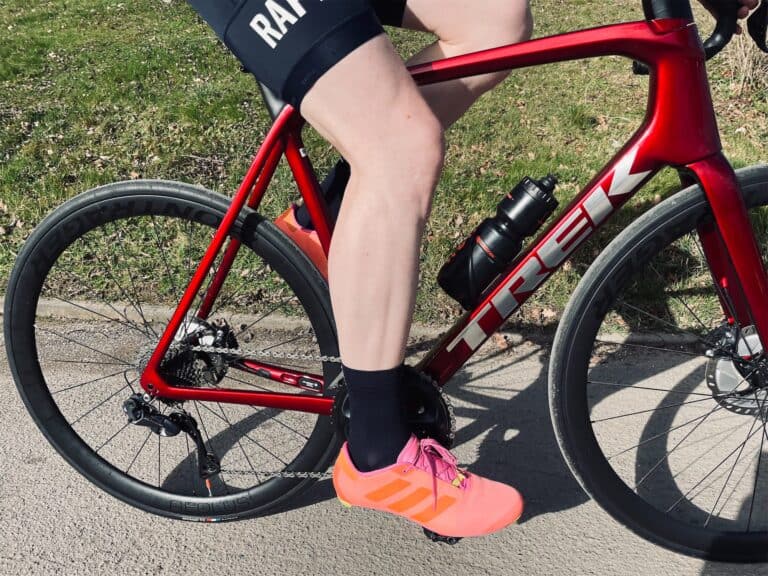
Sit bone pain after cycling
When I first started riding, my backside ached because I wasn’t used to it. Over time, I built up a tolerance for sitting on my saddle and didn’t have that kind of pain again. It happened from trying to ride too much too soon.
However, sit bone pain can be caused by using the wrong or improperly placed saddle. You need a saddle with the correct width to support your sit bones, and many people, like myself, find that a saddle with a cutout is much more comfortable than one without.
You may have to experiment with different saddles or see your bike fitter to find the right one to relieve your sit bone pain.
More Common Cycling Injuries
Hand pain
Hand pain from cycling is typically caused by putting too much pressure on the different parts of your hands or wrist. For example, if your saddle is tipped forwards too far, you’ll have too much of your body weight resting on your hands. This can compress the nerves and make your hands hurt or feel numb.
On the other hand, if your handlebars are too wide, you may have trouble gripping them correctly, putting pressure on a different nerve in the hand and making them feel numb and tingly.
Hand pain can also be a sign that you are gripping your bars too tightly, that you need more padding in your gloves and handlebar tape, or that the road surface is really, really bumpy!
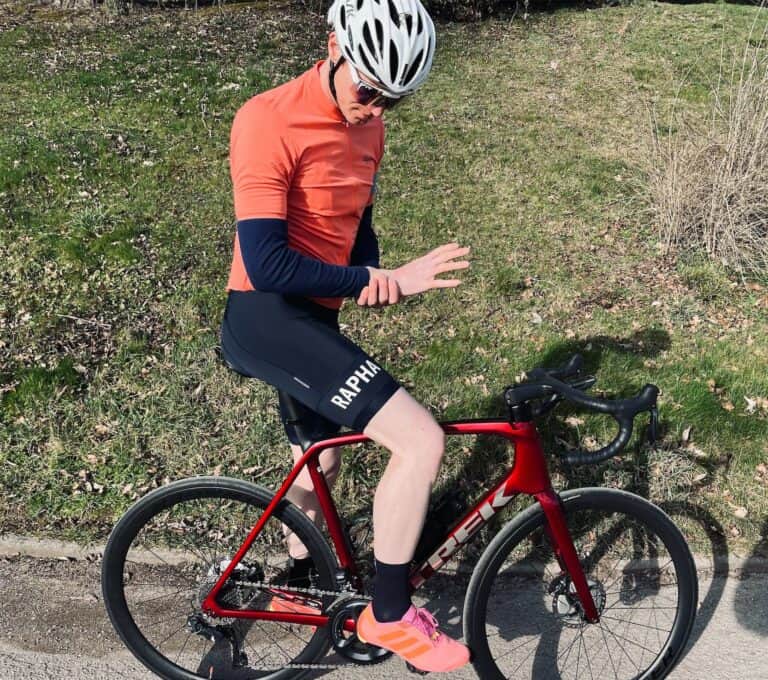
Hot spots on your feet
If you feel hot spots on your feet, it might be because your shoes or cleats are improperly fitted. For example, if your cleat is adjusted incorrectly, you might put pressure unevenly on your foot. Where it rubs against the shoe can feel hot and painful, leading to a hot spot when you ride.
Road Rash
A lot of accidents on the bike lead to road rash. It isn’t a rash per se, but a spot on your skin that gets scraped and scratched when it scrapes along the road surface. Wear quality cycling clothes for as much protection as possible (including gloves), and always work on your bike handling skills to reduce the risk of a crash.
Back Pain
Back pain can be caused by many issues, such as a weak core or muscle fatigue from going long and hard on the bike. However, Cycling Weekly points out that a lot of our back pain on the bike is actually from what we do off the bike – like sitting at a desk for long periods. So if you have back pain while cycling, of course, you’ll want to check your bike fit, but you may need to consider other lifestyle issues, as well.
Final Thoughts on Preventing Bike Injuries
To sum it up, the best way to prevent injuries on your bike is to make sure your bike fit is dialed in, balance your training plan both on and off the bike, and take any serious issues to your bike fitter or your doctor for more help. There’s no need for suffering on the bike – well, except when you are riding up that big old climb!
Related Questions on Cycling Injuries
How can you treat a sore bum from cycling?
Your bum can also be sore from saddle sores. A saddle sore is like a pressure sore, where the skin breaks down from the friction of your saddle and sometimes gets infected. They often resolve on their own, but if they are especially painful or don’t recede, you may need to see your doctor.
Bike saddle pain in your sit bones?
Another way to prevent saddle pain is to wear a high-quality chamois and a generous helping of chamois cream.
How to treat shoulder pain from riding a road bike?
Shoulder pain from riding a bike is often caused by reaching too far to hold the handlebars or using bars that are too wide or too narrow. It could also be from riding in the wrong saddle position, which puts too much weight on the hands. So, of course, a good bike fit will prevent this.
However, shoulder injuries often happen from crashes. For example, you could dislocate your shoulder or even break your collarbone if you put your arm out to catch yourself when you fall.
First, always be working on your bike handling skills. Second, learn to fall as safely as possible to protect your head without putting other body parts – like your wrist or shoulder – at risk.
Is cycling bad for your knees?
Cycling isn’t generally bad for your knees because it is a low-impact exercise. If you have knee pain from riding, you’ll want to explore the cause before it gets serious.
